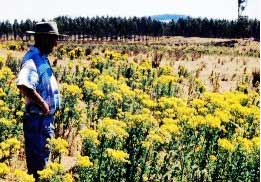|
Planting to Reduce the Spread of Weeds

Weeds are unwanted plants that compete for moisture, nutrients,
sunlight and growing space needed by trees, crops and native
vegetation. Weeds are generally difficult or expensive to
control because they grow rapidly and produce large numbers
of seeds that are easily and widely dispersed. Weeds that
are not native to an area can be particularly menacing, as
they often don’t have any natural predators that provide
natural controls to their growth and distribution. Farm forestry
can be used to suppress infestations and control the spread
of weeds. However, many introduced tree species are also potentially
weeds themselves and some types of farm forestry make controlling
them more expensive.
In some large areas infested with weeds it is often too expensive
or impossible to remove weeds. One solution is to plant the
affected area entirely with trees to suppress the weeds. The
most appropriate species are usually those that can form a
dense canopy that quickly shades the weeds and suppresses
growth and reproduction. For example, dense plantations of
pines have been used to control the flowering and spread of
serrated tussock in Victoria. After just 5 years the weeds
were under control, thereby reducing the risk of spread out
into adjacent farmland. Depending on what is present, a site
may become clear of weeds after just a few years. But many
weed seeds can stay dormant in the soil for many years.
Trees may also be able to stop the spread of weeds by slowing
the wind and capturing wind-blown seeds. Trees can also attract
a variety of plant-eating insects that may help in controlling
weeds.
As pasture restricts weed growth, trees can indirectly encourage
the spread of weeds by reducing pasture quality and vigour.
Trees also prevent the use of cheap control options like grazing
or broadacre spraying and hiding weeds from view.
Many introduced commercial tree species are themselves weeds.
For example, pines are able to invade native forest due to
their tolerance of shade and tagasaste, a promising fodder
tree is a serious weed of native forests on sandy soils in
Victoria. Farmers need to be aware of the risks of introducing
new species to an area that might be spread by stock, birds,
wind, water or other means. Once established, like willows
in streams, the cost of control can be very much more than
the contribution these trees might make to agriculture.
Back to top
|
